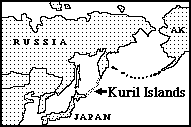
Spider Collector's Journal (6th page: Kuril 1994) © 2005 by Rod Crawford
As explained on the first page, most of these notes of fun (and not so fun) trips to collect spiders for research at the Burke Museum appeared in Scarabogram, newsletter of "Scarabs: The Bug Society," in their original forms. References to the editor mean me. Dates head each paragraph. Color Russian topographic maps have a black square 4 km grid for scale; contour interval is 40 m. RETURN TO INDEX
40 Days in the Kuril Islands
(by One Who Has Tried It)
 |
This summer, yr editor and Scarab Gara were members of a zoological expedition to the Kuril Islands (as you can see from the map at right, I've anticipated your next question!). These islands, at the same latitude as the Pacific Northwest, are distinctly cooler despite Oriental vegetation. Until this year, politics and location have made them off limits to Western scientists, leaving their biota unstudied. Studying the spiders and insects of this terra incognita was most exciting, as were teaming up with Russian colleagues; living on a ship for 40 days; and seeing a corner of the world where Americans were previously barred. If my narrative seems to harp on negative aspects, it's only that those are the most interesting parts; I did have a good time. All thanks to Professor Ted Pietsch for organizing and obtaining funding for the International Kuril Islands Project (IKIP), and to the National Science Foundation for funding it!
21 VII 1994: Leaving Sea-Tac Airport in the morning via Alaska Airlines (may their name live in infamy) were leader-ichthyologist Ted Pietsch, his assistant Brian Urbain and student Andres Lopez, malacologist Jack Burch and student assistant Suzanne "Zan" Lindsay, Scarab Bob Gara and student Noboru Minakawa (aquatic entomology), arachnologist (me), and communications man (Wayne Palsson). Like all flights to the far east we went by way of Anchorage, Alaska. On taking off from Anchorage for Russia, we were informed that the bulk of our expedition supplies, shipped by air freight 1 or 2 weeks earlier, were still sitting on a loading dock in Anchorage and would not go for at least another week! Grrrr! Throughout the 7-year Kuril project and 3 year Sakhalin project, every time we were forced to use Alaska Airlines for any part of the trip, they managed to foul up our baggage in some little way or other. Give me Aeroflot any time. Anyway, we touched in Petropavlovsk (Kamchatka Peninsula), Magadan (Siberia), then flew direct to Khabarovsk across the Sea of Okhotsk, which in late July still had lots of pack ice! Finally we arrived at Vladivostok which, being across the International Date Line, was on...
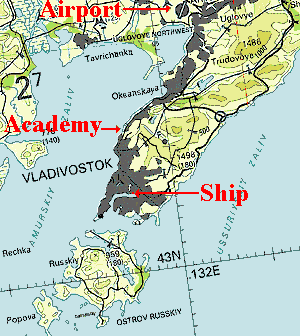 |
22 VII 1994: The Vladivostok Airport (some distance north of the city which is on the tip of a long peninsula) had (and still has) decidedly bumpy runways, but the great advantage of a family of cats living in the public area of the passenger terminal. Here we met the Russian expedition head, malacologist Viktor Bogatov, Academic Secretary of the Marine Institute of the local Russian Academy of Science branch: a schemer with decidedly Russian ideas on how to run an expedition. The Russian team included three of the loveliest women in Vladivostok (truly a city of beauties), malacologists Larisa Prozorova and Elyena Sayenko and entomologist Valentina Teslenko; also botanist Yuri Zhuravlyov and my spider colleague Kirill Eskov. We were to live on the expedition ship, Professor Bogorov (which after 2 summers I came to look on as a second home).
24 VII 1994: Satisfying Russian bureaucracy required a several day stay before embarkation. Time was occupied by touring the Academy (which we reached by train, fare about 40 cents American) and the city (which at this time seemed grimy and economically depressed, but improved amazingly in later years) and scrounging for supplies to replace those left in Alaska. Already at this time the city had an outstanding public transportation system of trains, trolleys, buses and ferries up and down the Golden Horn harbor (see map). A Russian ferry is quite a different experience from the Seattle variety. Instead of waiting around while the crew makes everything safe enough for a 5 year old, you just hop on and off across a 2-foot water gap! On Sunday the 24th, our hosts arranged a boat excursion to the island of Popova (bottom of map above) which had a few houses and some nice beach meadow, forest understory, and litter habitat where I collected 19 spider species, most useful later for comparison with Kuril Islands species. Then we gathered in one of the island houses for a feast of fresh scallops brought up that day by the expedition's divers. Yum! Banquets and other meals were to be a major theme of these expeditions. Butterflies collected on Popova were left out in the ship's laboratory overnight to dry. I don't know why we didn't realize there'd be rats on board. Those specimens are now mounted as wings glued to cardboard -- the bodies were eaten!
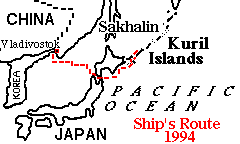 |
26 VII 1994: We're off! Another member of the ship's fauna was the German cockroach, Blattella germanica, found in my and Kirill's cabin but oddly enough, commoner close to the kitchen! However, there was nothing wrong with the food except perhaps a little too much salmon. Shipboard routine starts with a wake-up on the ship's P.A. (in Russian, which fortunately I had taken in high school) at 7AM, breakfast at 7:30, lunch at 11, tea at 2, and dinner at 6! (On field days, tea is skipped, lunch is on shore and dinner's at 7). During the few days of our sea voyage to the island of Kunashir, we passed through the Straits of Tsugaru, Japanese territorial waters, so I can now say I've been in Japan even though I'd never set foot there! [Until 2001, that is.]
 |
| Kunashir: 123 km long 1994 collecting localities in red |
31 VII 1994: After waiting a day for local bureaucrats to make up their minds about us, here we were on land on the island of Kunashir! Today's field trip was to establish a pattern. Everyone was hauled to the same destination, usually a coastal interdune lake, no matter that only half of us were aquatic biologists and the rest would have preferred uplands once in a while. Today's goal was Lake Aliger on the west coast of Kunashir (our ship was docked at the east coast city Yuzhno-Kurilsk but we had vehicles for once). I set pitfall traps first thing; the last I would set on the trip, for we would never again visit a spot and be told whether it would ever be possible to return to pick up the traps! Kirill and I (the trip's spider-men) finding nothing to do on the dunes, hiked inland at the expense of a wet ditch crossing, where we found fairly productive habitats: alder thicket, lush meadow with lots of wild rose, spruce forest, oak forest, and a small bog. Then it developed that we were supposed to hike all the way back to the beach just to consume a hot lunch (on an 80° day)! It seems that Viktor and his cohorts were excessively worried that American visitors would get into trouble without plenty of baby-sitting. After this day, I managed to exempt myself from interrupting the day's work for a lunch in camp, but only because I was with my Russian colleague.
1 VIII 1994: While the others headed for another shore habitat, Kirill got us dropped off at a large Sphagnum bog he spotted while crossing the island yesterday. This proved to be productive, though late in the season for best collecting. We sifted Sphagnum, swept bog herbs, beat spruce foliage (Picea glehnii), and brushed a few interesting spiders off spruce bark. Later that day, I got some very familiar "house" spiders from crates and sheds at the docks in Yuzhno-Kurilsk. Our shipmates adopted two black kittens, destined to make life more homelike in the ship's labs.
2 VIII 1994: We all took a long, long drive down the length of the island, through many tantalizing upland habitats, finally stopping (guess what) on a beach at the south end by the estuary of the River Rikorda. I collected from a disturbed village field, dry sandspit meadow, and river bank, getting a few interesting things, most notably the classic Eurasian Agelena labyrinthica which makes a huge funnel web.
3-4 VIII 1994: Upland at last! Thanks to a hot spring where the crew wanted to soak, we spent the morning at the confluence of the Lesnaya and Kislyi Rivers (one cold water, the other warm: the Kislyi wells from hot springs on the slopes of Mendeleeva Volcano). At elevation 60 meters, we had a spruce-fir forest, an alder-maple-birch forest with tall Sasa (dwarf bamboo) understory, and a cobbly river bank where I got the quite rare Taranucnus nishikii (formerly known only from Japan) under stones. The most productive site of the island, it was again visited (after an afternoon in the fog at another coastal estuary) the next day, when I collected from litter and understory in the mixed forest. I little suspected that lurking in that understory was the plant Toxicodendron orientale! At the end of the day, with difficulty I persuaded a driver to help me pick up my pitfalls - which contained a Pachygnatha species previously known from Yugoslavia, one of our more amazing spider finds.
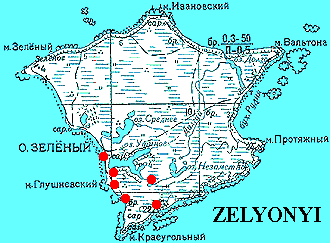 |
5-6 VIII 1994: Leaving Kunashir, we landed by lifeboat on Zelyonyi (green) Island, largest of the Habomai group at 10 km maximum width. They say it formerly had several trees but they were washed away by a tsunami around 1960. Now the whole low, flat island is meadows and wetlands. No one lives here but a hermit or two and a small Russian Army garrison who were delighted to have visitors - especially female! I retain a vivid picture of young Zan from Michigan bracketed by adoring Russian soldiers. They were reluctant to let us go, so we didn't get to collect away from the beach until late; therefore we came back a second day. I combed the SW quarter of the island, collecting in beach habitats, all kinds of meadows, a small bog, abandoned shacks, and a gravel pit. Several spider species were taken by the expedition only here. Our non-city landing procedure was now established. We'd climb down the ship's side on a rope ladder into the large wooden lifeboat piloted (sometimes through large waves) by super-capable Mischa Shubin. This year we had no motorized rubber landing craft, so unless there was deep water to shore or some sort of natural dock, we'd often have to wade onto the beach. And that is how the Toxicodendron toxins on my field pants soaked through to my legs.
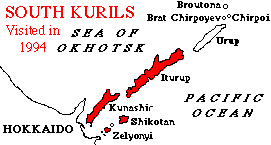 |
9 & 11 VIII 1994: Alas, we spent only two partial days on Shikotan, where I got the greatest spider diversity (for time spent) of the trip. On the afternoon of the 9th, we landed in Otradnaya (pleasant) Bay, amid truly gorgeous scenery, rock cliffs and grassy slopes with scattered tree groves. Some groves were birch and some were spruce-fir with no clear cause for the species difference. After a little fair collecting in near-shore habitats, Kirill and I hiked inland through the "Island Milk Farm" to a side canyon from which I was able to climb a nice high hill, and get out of the pesky little flies which are the one drawback to this lovely island. Collecting was splendid for 2 hours until an urgent call back to the ship came over my walkie-talkie! One disadvantage to being on a hilltop, you have radio reception! I was able to relay the message to my equally reluctant comrades scattered over the landscape, and back we went to the ship and some vague explanation about a storm warning; we suspected the storm was bureaucratic. After an idle day, with a rash developing on my leg, we got back to Shikotan at a much less interesting grassland site near Del'fin (dolphin) Bay on the west end. A foggy day gradually developed into rough weather and Mischa showed his mettle getting us safely back on board.
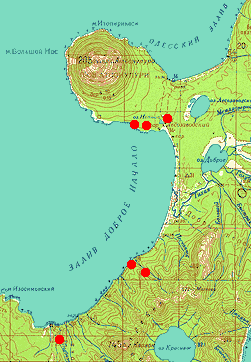 |
12-14 VIII 1994: More spectacular scenery. For our first day on Iturup (largest Kuril island at 200 km long and 6725 square km), we sailed by the awe-inspiring Atsonupuri, a perfect 1205-meter volcanic cone rising straight out of the sea, at the north entrance to Dobroye Nachalo (good beginning) Bay: see map, right. A lava flow of a few centuries past has made a natural dock where we landed at Lesozavodskii, once a village but now home to only two families who use an army surplus tank for transportation. We later saw another one in a driveway! The mixed forest of fir, birch, alder, mountain ash and elderberry (Asian species related to familiar American trees) on the volcano's lower slopes proved reasonably productive of spiders. On the second day here, the others headed for Dobroye Lake (coastal, low and estuarine as usual) while the spider-men hiked down the coast to a stream leading up into the hills. At 80 m elevation, we found a nice spot with both fir and birch litter to sift and dense bamboo understory to beat; a couple of new species were found here. On the third day at Dobroye Nachalo we divided forces, me staying near the "village" to further inspect the lava flow forest while others crossed the bay to the Podbaza River. On this day I found a little cave (semi-artificial) which yielded males of the rare Taranucnus and an undescribed orbweaver. A side trip to tiny Lake Natasha produced riparian species.
16 VIII 1994: Konservnaya (cannery) Bay, on the east side of the "thumb" sticking up from Iturup (see map), is a picturesque spot that soon would be all too familiar to us, for we went there every year (sometimes twice) to take on fresh water at a waterfall plunging from an uninhabited plateau. The main habitats available were mixed deciduous forest (from this point northward there are no fir trees) and beach habitats; the cobbly beach produced good series of a new jumping spider, genus Sitticus. The landing today was wet, and with rolled up pants the ship's doctor got a good look at my leg, now becoming ulcerated. That night I got a lecture by proxy about the dangers of Toxicodendron (a worse relative of American poison ivy), treatment with silver nitrate, and orders to remain on board for a few days unless I could land without getting wet.
17-18 VIII 1994: Fortunately, landings at town docks gave me two more field days while convalescent. On the 17th we landed at Kurilsk (SW of the "thumb") and walked to Lake Lebedinoye where spider collecting was reasonably productive in nearby forest and fields. On the 18th, we landed at Reidovo (east base of the thumb) and started a longish hike destined to end at another coastal interdune lake. Brian and I escaped the main party and located what proved to be an extremely nice Sphagnum bog with little larch trees growing in it, the northernmost conifers we found except for shrub-height pines and yews growing in more northerly islands. The bog moss, herbs, and larch foliage were all productive of spiders. This day served to give Brian some spider training, for he was to become the spider-man for future wet landfalls. Having some "down time" turns one's mind to recreation. The presence on our team of a young lady named Zan made the temptation to a limerick irresistible:
There was a young lady named Zan
Who searched all the world for a man.
She braved many perils
Exploring the Kurils,
But only came home with a tan.
I need hardly say that in real life, this young lady had no trouble finding a man. And I almost forgot to mention Blinov, the eccentric diver, whose bizarre behavior made him a constant subject of crew gossip. The following year he went too far, and for reasons best known to himself, threw the ship captain's motorcycle overboard! Exit Blinov.
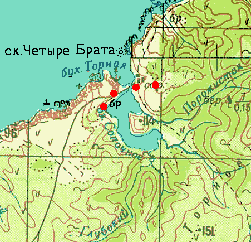 |
19-21 VIII 1994: I nursed my leg on board while Brian got a bumper crop of mostly immature spiders near Lake Sopochnoye, what we were coming to call a typical Bogatov lake, bordered in part by dunes and with a short connection to the sea. The map at right might serve for all such lakes. The following day, Brian got a smaller collection in meadows above Slavnaya Bay, near the north end of Iturup, and made the fascinating discovery of a wolf spider in sand burrows on the seashore there. On the 21st, the crew managed to get me on shore dry at the nearby Glush' River, where Kirill and I hiked up a steep road to 90 meters elevation, the highest (sad to say) from which spiders were taken on Iturup. Leaf litter, roadside herbs, and dead wood produced quite a few spiders here. Later, while waiting for the boat, several of us excavated more sand burrows of what proved to be the large Lycosa ishikariana, previously known from Japan.
22 VIII 1994: Our last day on Iturup started at a completely typical "Bogatov lake" on the shore of Kuibyshevskii Bay, but Kirill and I hiked (as usual) away from this boring habitat and found a nice larch forest on the appropriately named Listvennitsnoye (larch) Plateau. Unfortunately, lots of Toxicodendron was lurking under and among the bamboo just within the trees, but I got lots of interesting spiders from the forest edges.
24-25 VIII 1994: On our way south, a last stop on Kunashir. We'd never collected on the north third of the island, where Tyatya Volcano, at 1819 meters the highest peak in the islands, is located with other nice uplands. So where did we land? You guessed it - at Krugloye (round) Lake, on a long flat peninsula, elevation 12 meters, separated from the sea by a narrow dune. We never got closer to Tyatya. Even the aquatic people were disappointed by this lake. On the last day, back at the capital city Yuzhno-Kurilsk, the others wanted to soak in a hot spring and wonder of wonders, I managed to get permission to go off by myself. I hiked north on the coast road and found a coastal Sphagnum bog which had lots of spiders but, as it turned out, not many species. However, some were new for the island. And so, as the sun sets behind Tyatya, we say farewell to the Kuril Islands - for now.
After a few days producing a mountain of paperwork to legally export our specimens (including 4800 spiders and harvestmen) we began an uneventful flight home. In the meantime I had met spider-man Yuri Marusik (now an old friend) and his gorgeous student Natasha, and with them attended a scientific conference in Vladivostok. That must be where I picked up the flu. Already feeling ill the last night on board, I had dark fantasies of not being allowed on the plane, so concealed my illness as well as I could. I had already arranged to stop off in Ketchikan on the way home, on a job for the state of Alaska to search for hobo spiders, Tegenaria agrestis, so I was hoping this flu would be short. No such luck; I spent two nights flat on my back in cheap lodgings in Ketchikan, followed by a day or so's rather limp collecting, and then home to Seattle. That fall, there was almost no Washington spider collecting. But it was quite a year anyway.
One month later on October 4, there was a magnitude 8.1 earthquake, generating a 10 m tsunami, just off the coast of Shikotan. At the time, news flashes (from a reporter far away in Moscow) raved "everything was destroyed," but 2 years later most of the buildings looked much the same. You can't do much to an unpainted wooden shack. It would have been quite an experience, but on the whole I'd have to say I'm glad we weren't there!
This page last updated 21 March, 2025